
| Original Research Online Published: 10 Feb 2016 | ||||||||||||
Ulutas Med J. 2016; 2(1): 41-46 Do Patients Perform Their Exercises at Home and why (not)? A Survey on Patient Habits during Rehabilitation Exercises Bruno Bonnechere, Bart Jansen, Lubos Omelina, Serge Van Sint Jan.
| ||||||||||||
| How to Cite this Article |
| Pubmed Style Bonnechere B, Jansen B, Omelina L, Jan SVS. Do Patients Perform Their Exercises at Home and why (not)? A Survey on Patient Habits during Rehabilitation Exercises. Ulutas Med J. 2016; 2(1): 41-46. doi:10.5455/umj.20160210060312 Web Style Bonnechere B, Jansen B, Omelina L, Jan SVS. Do Patients Perform Their Exercises at Home and why (not)? A Survey on Patient Habits during Rehabilitation Exercises. https://www.ulutasmedicaljournal.com/?mno=216539 [Access: March 15, 2025]. doi:10.5455/umj.20160210060312 AMA (American Medical Association) Style Bonnechere B, Jansen B, Omelina L, Jan SVS. Do Patients Perform Their Exercises at Home and why (not)? A Survey on Patient Habits during Rehabilitation Exercises. Ulutas Med J. 2016; 2(1): 41-46. doi:10.5455/umj.20160210060312 Vancouver/ICMJE Style Bonnechere B, Jansen B, Omelina L, Jan SVS. Do Patients Perform Their Exercises at Home and why (not)? A Survey on Patient Habits during Rehabilitation Exercises. Ulutas Med J. (2016), [cited March 15, 2025]; 2(1): 41-46. doi:10.5455/umj.20160210060312 Harvard Style Bonnechere, B., Jansen, . B., Omelina, . L. & Jan, . S. V. S. (2016) Do Patients Perform Their Exercises at Home and why (not)? A Survey on Patient Habits during Rehabilitation Exercises. Ulutas Med J, 2 (1), 41-46. doi:10.5455/umj.20160210060312 Turabian Style Bonnechere, Bruno, Bart Jansen, Lubos Omelina, and Serge Van Sint Jan. 2016. Do Patients Perform Their Exercises at Home and why (not)? A Survey on Patient Habits during Rehabilitation Exercises. THE ULUTAS MEDICAL JOURNAL, 2 (1), 41-46. doi:10.5455/umj.20160210060312 Chicago Style Bonnechere, Bruno, Bart Jansen, Lubos Omelina, and Serge Van Sint Jan. "Do Patients Perform Their Exercises at Home and why (not)? A Survey on Patient Habits during Rehabilitation Exercises." THE ULUTAS MEDICAL JOURNAL 2 (2016), 41-46. doi:10.5455/umj.20160210060312 MLA (The Modern Language Association) Style Bonnechere, Bruno, Bart Jansen, Lubos Omelina, and Serge Van Sint Jan. "Do Patients Perform Their Exercises at Home and why (not)? A Survey on Patient Habits during Rehabilitation Exercises." THE ULUTAS MEDICAL JOURNAL 2.1 (2016), 41-46. Print. doi:10.5455/umj.20160210060312 APA (American Psychological Association) Style Bonnechere, B., Jansen, . B., Omelina, . L. & Jan, . S. V. S. (2016) Do Patients Perform Their Exercises at Home and why (not)? A Survey on Patient Habits during Rehabilitation Exercises. THE ULUTAS MEDICAL JOURNAL, 2 (1), 41-46. doi:10.5455/umj.20160210060312 |







